In the frosty, pre-dawn darkness, three friends and I pulled off on a lonely stretch of road in Windham County, Vermont. The aging Subaru had bumped and heaved over the frozen ruts. We emerged, grateful to have our feet back on solid ground, and stumbled through the woods until we found what we were seeking – a mysterious stone chamber set into the hillside like a passage to an underground world, its dark opening constructed of massive stones. Exchanging silent glances, we crawled through the narrow door. There was barely room for the four of us. The ceiling was no more than three feet high. The ground beneath us was frozen. We doused our headlamps and waited in the darkness.
Shortly after we settled, the sun rose over the horizon. A beam of light shot through the entrance to illuminate an unusual stone in the back of the chamber and the cramped space filled with a fiery glow. We had hoped that this might happen, but the hope did nothing to diminish our surprise, wonder, and, at least on my part, a sense of reverence. Nor did it do anything to alleviate my curiosity. Who had built this strange underground room that lit up with sunlight on this particular morning? And for what purpose?
When we visited that stone chamber on the vernal equinox of 2008, I was unaware of the scope of the mystery I had stumbled upon. But as I shared the story, I learned from my neighbors that this unusual stone room was not the only one of its kind. The forests of New England are littered with stone relics. Best known, of course, are the stone walls and cellar holes of nineteenth-century settlements. But among them are stone structures with origins that are harder to explain: underground chambers, stones set on end to stand like pillars, massive cairns.
The neighbor who introduced me to the chamber I visited called it the Pig Pen and told me that early farmers had built it to contain swine. That same neighbor led me to another underground room, which was invisible until he moved a pile of stones and lowered himself through a hole into the darkness below. It was constructed of un-mortared stones, the shape of a subterranean beehive. Spacious enough for several adults to stand in, the chamber smelled musty and felt mysterious and ancient. Local lore has attributed a tidy explanation: It was called the Slave Pit, a presumed stop for escaped slaves traveling the Underground Railroad on their way to Canada.
But after watching the equinox sunrise light up the Pig Pen, I began to question these stories. Why would settlers have invested such enormous effort and moved such massive stones (some of which must have weighed over a ton) to put a roof over swine? Why did they gouge a groove over an inch deep into the bedrock that comprised the doorsill? Was it coincidence that the Pig Pen is positioned to capture the sun as it rises over Mount Monadnock on the morning of the winter solstice? Perhaps there was more to the story than my neighbors knew.
Piles of Stone
Not far from the summit of Glastenbury Mountain in Southwestern Vermont, the Long Trail passes by an old fire tower. A series of low stone mounds lie nearby. Five in number, they stand two to four feet high and nearly eight feet in diameter. It is not unusual to see piles of stone in New England. Farmers left them wherever they settled to make way for construction or cultivation. But these strange and carefully crafted cairns stand on a remote mountain top that’s miles from any colonial cellar hole.
Mountain travelers have long used stone cairns on open summits to serve as guides when visibility is low, and it would be reasonable to assume that trailblazers built the cairns. At least, it would be reasonable if Glastenbury had an open summit. But the mountain is completely wooded, as it was when the first major trail was cut to its summit in the early 1900s.
Most trail-marking cairns are built as tall stacks or cones to make them easy to find during stormy days, but the Glastenbury structures are barrel shaped, wide and low. Most cairns are built from small stones that are easy to move, but the Glastenbury cairns are built from boulders, some weighing hundreds of pounds.
The unusual nature of the cairns caught the eye of Norman Muller, Conservator of the Princeton University Art Museum, who has studied stone structures throughout the eastern United States. Muller had seen a similar site in Windsor County, Vermont, with over 100 cairns. He had long suspected that they might have prehistoric origins, but they stood amid the ruins of old Vermont farms. Might the Glastenbury cairns, isolated as they were, offer some clues to their antiquity?
To find out, Muller enlisted the help of Tom Wessels, author of Reading the Forested Landscape, and they visited Glastenbury during the summer of 2007. They mapped and measured the mounds and observed the surrounding forests. They measured the depth to which forest debris and soil had accumulated. They noted the thick layer of moss covering the rocks, suggesting that the stone structures might be far older than the mountain’s trails. Wessels concluded that the structures were “much older than 200 years,” even that they pre-dated European settlement in the region. Wessels wrote, “Those cairns obviously have nothing to do with agriculture. They clearly predate the fire tower and original hiking shelter, based on their moss development.”
“The evidence from the Glastenbury cairns,” says Muller, “strongly suggests they were constructed by Native Americans.” But according to both oral history and the archaeological record, precontact Native American settlement in southern Vermont centered on the shores of rivers and lakes. The nearest navigable waterways to Glastenbury are a dozen miles away over rugged terrain. Perhaps the structures served some ritual or religious function, but there are no records of the region’s Native populations creating similar structures.
However, this does not mean that there aren’t analogues out there. David Lacy, an archaeologist with the Green Mountain National Forest, suggests looking at similar stone structures a bit farther afield. “There are (not identical but perhaps comparable) stone works in the Appalachians to the south.” Archaeologist Harry Holstein of Jacksonville State University has excavated these cairns in larger numbers, and found that while some are ambiguous, some are clearly prehistoric.
When I asked Lacy what he thought about the origin of Vermont’s unusual cairns, he pointed to the need for more data. “There are some cynics out there who say, ‘We know what they are. They’re nineteenth century.’ And I’m inclined to think that that’s true. But when you look at what Harry’s demonstrated in the southern Appalachians – that a proportion of the ones he’s excavated actually have Native material in them – there is a case to be made that these are Native.”
Ancient Mariners
Bart Johnston’s backyard in rural Chittenden County, Vermont, affords an incredible view of Mount Mansfield. On the fine summer day that I visited, Johnston asked me to consider a third possibility – that ancient European mariners were the ones who built these hard-to-explain stone structures. As we walked through the woods behind his home, he pointed out impressive dry-masonry structures with unusual features. The stones were enormous. The largest ones must have weighed several tons each. And they were all meticulously oriented 22° north of east. When we came upon a particularly massive and beautifully crafted stack of stones, he stated passionately, “A bunch of hardscrabble, backwoods farmers did not build this.” Nor did Native American builders, Johnston believes. “I think they’re Celts.”
Johnston’s theory is that thousands of years ago New England was home to groups of ancient Celtic peoples who crossed the Atlantic from Europe, and that the structures near his home represent an ancient ritual site. Johnston is not alone in this belief. In our tour of his property, we were joined by spirited members of the New England Antiquities Research Association (NEARA), an organization dedicated to researching unusual stone sites. Across the Northeast, this community of enthusiasts, intrigued by sites like the one at Johnston’s property, have joined together to identify, document, and try to explain them. Many NEARA members vigorously support the idea that these structures are evidence of pre-Columbian settlers from ancient Europe.
At the heart of this controversial idea is the largest and most impressive stone site in New England – Mystery Hill, in Salem, New Hampshire, also known as America’s Stonehenge. Of all the hundreds of stone ruins across New England, none has garnered more attention. A complex of chambers, walls, and standing stones, this site has attracted visitors for over a century.
I asked Dennis Stone, whose family has owned and managed the site as a museum since the 1950s, who he thought built the structures at Mystery Hill. “It’s not conclusive,” he said, “but we think that the site and other sites in New England suggest Old World visitation to the New World from the Mediterranean Sea and the Iberian Peninsula.” He states that an excavation at one of the America’s Stonehenge chambers unearthed charcoal that was radiocarbon dated to about 4,000 years ago, that a number of stone tools were found there, and that the stones of the chambers were quarried without metal tools, using Stone Age techniques. There are striking similarities with structures in the Old World. “The size, shape, and orientation of these structures look very much like what’s on the other side of the ocean,” he said.
Then there are the unusual astronomical alignments. Inspired by the other Stonehenge (in England), the Stone family began clearing around the large, arrow-shaped, vertical stones at Mystery Hill to find out if, perhaps, they had some astronomical purpose. By 1973, they’d discovered a number of astronomical alignments, and by 1977, they had surveyed so many that they felt that there must be some significance. Various stones through the site could be used to observe the movements of the sun on the solstices, equinoxes, and the cross-quarter days that fall midway between them. Others marked the lunar standstill and the passage of the moon through its 18.6 year cycle. There were 24 different star alignments. “I don’t think they’re coincidental,” Dennis told me. “You can only have so many before it becomes something you have to assume was set up deliberately.”
And Mystery Hill isn’t the only site with these kinds of alignments. In Massachusetts, Byron Dix and Jim Mavor have carefully documented the alignment of stone chambers that observe the rise of the Pleiades over distant cairns. “The odds against random location,” they concluded, “and therefore favoring purposeful design for astronomical purposes are considerably greater than one million to one.”
But astronomical alignments are not the strangest of the mysteries that Stone describes. He also tells of two triangular stones excavated at Mystery Hill and inscribed with text-like markings. These stones sat in America’s Stonehenge’s museum with no explanation until Barry Fell, of Harvard University, visited the site in 1975. Fell, a translator of ancient inscriptions, took an interest in the stone tablets. “His conclusion,” Stone told me, “was that one [of the inscriptions] was Libyan. But it was difficult to make out what the inscription said. Part of it was pretty weathered. It looked like it was partly missing. The other was identified as being Iberian Punic or Phoenician. It said the structure was supposed to be dedicated to Baal on behalf of the Canaanites.”
A marine biologist by profession, Barry Fell is best known for his book, America B.C.: Ancient Settlers in the New World, which popularized the idea that ancient mariners crossed the Atlantic Ocean to trade, explore, and settle in the Americas. Fell claimed to have translated inscriptions found across eastern North America, which showed that Iberian Celts had settled New England 3,000 years ago. Here they founded a kingdom named Iargalon, and settlements supposedly continued until the early days of the Roman Empire. Phoenician and Egyptian traders were said to have made regular visits to the American coast and intermarried with Native people to become the Wabanaki of northern New England and the Maritimes. He even claimed to have found inscriptions showing that Egyptians and Libyans penetrated the Mississippi River watershed as far as Iowa, the Dakotas, and Arkansas.
Curiouser and Curiouser
As my investigations continued, I came to feel that unpuzzling the mystery of New England’s stone structures was like stepping through the looking glass; each new chapter was curiouser than the last. Each new site brought its own idiosyncrasies. Each new person had his or her own story. There were so many claims and so much purported evidence that it was daunting to imagine sifting through it all.
I sought a critical perspective to help sort genuine evidence from wishful thinking, and found it in Giovanna Peebles, Vermont’s State Archaeologist. Peebles has spent years researching these stone chambers and documented her findings in her exhaustively footnoted book Vermont’s Stone Chambers: An Inquiry into Their Past.
When Peebles signed on as Vermont’s state archaeologist in July of 1976, the buzz about New England’s stone chambers had reached its apogee. If these structures really were what people claimed, then they would be among Vermont’s top priorities for historic preservation. People were asking the state to investigate. And Peebles, as state archaeologist, was assigned to the investigation. “It was 110 percent of my time.” With the help of a federal grant, Peebles and two researchers examined every chamber, scrutinized the deeds for every parcel of land they were found on, scoured the history of each town where these chambers existed, and pored over century-old agricultural publications. And at the end of it, Peebles came away quite convinced that she had answered the questions that she had been charged with. “While there are still many archaeological puzzles in Vermont,” she concluded, “the stone chambers are not among them.”
The most telling clue was one she never found: the historical record contains no mention of chambers at all. Early European explorers, charged to record these new lands in detail, said nothing of them. Neither did early surveys or deeds. Wouldn’t a stone structure be the kind of feature that they would take pains to describe? Wouldn’t the discovery of a subterranean room by early farmers have garnered at least an intriguing footnote in the histories? Unless, of course, the stone chambers weren’t there to be found.
But what of the enormous size of the stones? “One of the polemics,” said Peebles, “is, ‘Well, Vermont farmers couldn’t lift these hundred-ton stones.’” But over the course of her research, she found example after example that showed that not only could colonial Vermonters move stones like this, they did it on a regular basis. “There are villages in New Hampshire where half the buildings were moved more than once…. People were moving hundred-ton structures almost daily.” The landscape of nineteenth century New England was one where the stone chambers would seem quite at home. Indeed, upon close inspection, the style and structure of many of the stone chambers closely matched the masonry in the remains of nearby farmsteads.
It is true that the New England chambers bear a striking similarity to some ancient Celtic structures in Europe. But Peebles points out that similarities of this kind don’t always imply a cultural connection. Often they result from people in similar landscapes with similar materials trying to solve similar problems. Still, context is important, so Peebles tracked down similar structures wherever she could find them. She stumbled upon nearly identical stone chambers in Iceland, all of them used as root cellars. On a tip from the cultural historian Eric Sloane, she researched farms in Pennsylvania, where she found beautifully illustrated records of historical root cellars. “And they looked just like our stone chambers.”
But if New England’s stone chambers were colonial structures, what of the thousands of inscriptions discovered by Barry Fell? Fell’s work was rejected by the archaeological community. Even as a lay reader it is easy to see why. He drew sweeping conclusions from the inscriptions that he found. He eschewed peer review and instead released his ideas in popular works and through an organization of fellow believers that he founded called the Epigraphic Society. Many of his inscriptions appear to be little more than scrapings on stones that could have pedestrian explanations. And his translations remain uncorroborated by other experts. When Anne Ross, a British authority on Celtic Ogam script, inspected some purported inscriptions in Vermont, she not only concluded that she could not accept them as Ogams, but also suggested that they were not “any form of script at all.” Some chambers, which Fell purported to be temples to Old World deities, based on associated inscriptions, even turned out to have documented historical builders. The marks found on Vermont’s stone monuments are, most likely, the marks of chains and other tools employed in stone construction during the nineteenth century.
But what about my unusual experiences at the Pig Pen and all the dozens of astronomical alignments? Peebles writes that “a strong nineteenth century concern with proper solar orientation” is documented both in the historical record and in observations of colonial structures. The old New England farmers may not have worshipped the sun as a god, but they certainly depended on a detailed knowledge of its movements to warm their homes and nourish their crops. The stone walls in my Vermont town are oriented with meticulous precision along bearings that reflect the sophistication of the surveyors who laid their paths.
But were Europeans in contact with North America earlier than we give them credit for? “It’s a really good question,” says David Lacy, “and the answer is probably yes. But then, does it follow that a small number of people came here and built a number of stone structures over a large geographical area and didn’t leave any archaeological evidence other than the structures? We’ve never really seen a good demonstration of anybody saying not only could they have been here, but they were here. I’m leaving the door open, but on the other hand, to assert that they were here requires you to have some evidence.”
What We Know – What We Don’t
In light of all of this, what can we conclude about New England’s stone heritage? First off, the vast majority of the mysterious stonework in the forests of the Northeast is surely historical in origin. Peebles determined that many of the chambers were root cellars, but there were a variety of historical uses for the chambers and other structures in her study. Some were foundations for massive stone chimneys. Others were used as pens for animals.
But archaeologists have not closed the case on all of New England’s stone structures. There are mysteries yet to be solved. Today, the focus has shifted from chambers, inscriptions, and standing stones to cairns like the ones in the Green Mountain National Forest. Of Vermont’s collection of cairns David Lacy says, “People jump to conclusions – that they are Native American, pre-contact European, or colonial. Often, they’re arguing from an ideological point of view. The truth is we need more data.”
I went back to the Pig Pen on a sunny afternoon last summer, and this time I brought my daughter. She’s four and full of questions – just like I was the first time I’d come. What is it? What’s it for? Who built it? I wanted to tell her that it was built by farmers about two hundred years ago when the whole hillside was cleared of forest; that it may have held roots in the winter or maybe even pigs; that people had forgotten who built it for almost a hundred years, and that rediscovering its true story took patience and work and care. If I’ve learned anything from researching these chambers, it’s how quickly we forget our own history.
But we perpetuate this illusion that our history is known, that we’ve puzzled out what it means. And our past is mysterious, more mysterious even than the stories that we invent to explain the few traces that remain – etchings on a gravestone, potsherds in a cave, piles of rocks in the woods. To tell my daughter that this stone chamber was built by a farmer is a bit disingenuous. It makes it sound as if the chamber’s story is known and understood. So instead, I tell her that we don’t know much, that we only have a few clues to go on. I tell her that the chamber is a mystery. “But,” I add, perhaps a little mischievously, “I do know that the sun lights up the whole thing on the first sunrise of spring.”


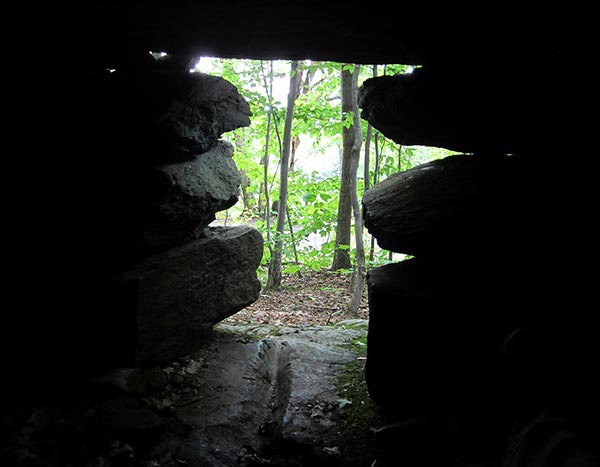
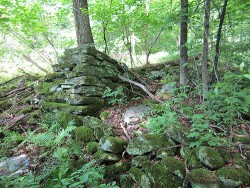
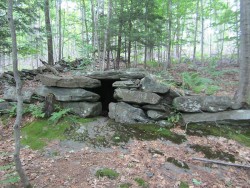
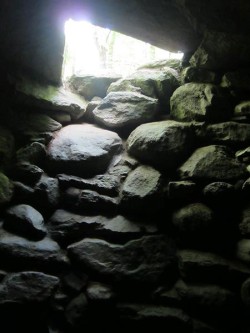
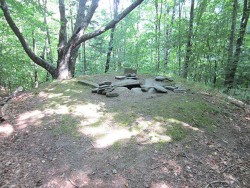
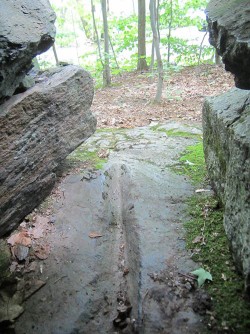
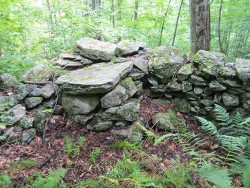
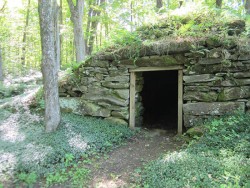
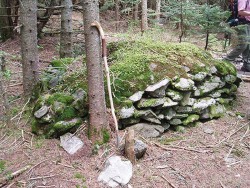
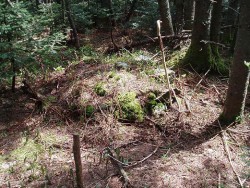
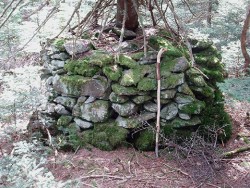
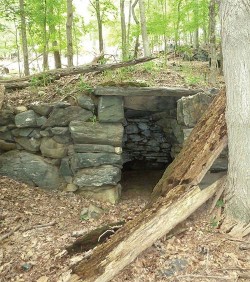
Discussion *